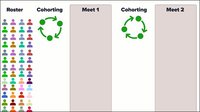Learning Counsel research shows a marked need to advocate for schools developing all nine human intelligences instead of focusing largely on just two: mathematical-logical and linguistic.
An August 2024 survey of educators with 225 responses showed that:
70% believe courses on AI for both teachers and students are needed to include not just accessing and using but how it works to empower students.
69% believe schools will need to develop programs to emphasize all nine human intelligences to balance AI.
63% believe a new form of work will emerge of teachers having to distinguish between student's own work and AI.
62% believe the teacher role will shift to focus on human interactions.
61% believe humans could grow overly dependent on AI.
61% believe there will be a disparity amongst populations due to the economics of access to AI.
60% believe there will be less work for teachers on mundane tasks like grading, differentiating resources, testing.
59% believe there will be fewer teaching jobs because of AI.
56% believe AI will provide more personalized learning for students without teachers.
55% believe there may coincidentally be more jobs for teachers or related fields developing curriculum and personalization for students.
What’s on the horizon is a convergence of not just the consumer-grade generative AI but all the “background” AI like recommendations engines, AI filters, machine-learning, spatial-temporal, voice and visual recognition, and more. Acting together, the all-AI might never achieve the true consciousness scientists speak of as the “singularity,” but certainly there will be a massive leap in customization and, indeed, sheparding of humanities interactions, attentions and inattention because many new tasks and comparisons and even thinking is being done for people. The potential for harm, what might be missing or disallowed by evil intent in datasets AI could access may also be threat to humanity. Already the internet alone has some folks pushing for severe censorship and a sort of intelligentsia over knowledge flows as if humans cannot distinguish false from true, good from bad. Indeed, many of them can’t, but that has always been true.
What about the Nine Human Intelligences?
Psychologist Howard Gardner’s Theory of Multiple Intelligences suggests that there’s more to being intelligent than simply being good at math and language.
Howard Gardner’s theory of multiple intelligences proposes that humans are not born with all the intelligence they will ever have, and that everyone processes information in different ways. In other words, we continually learn and develop in different ways throughout our lives, even after we finish formal education. This is different than some sciences that insist humans are born with an IQ that never changes and is part of genetics.
Gardner does not define intelligence as one single, general ability, but instead he divides it into nine different intelligences. While someone might be particularly strong in one area, such mathematical intelligence, they will actually possess a range of abilities across several intelligence types.
The nine are:
- Logical-Mathematical Intelligence
- Linguistic Intelligence
- Interpersonal Intelligence
- Intrapersonal Intelligence
- Musical Intelligence
- Visual-Spatial Intelligence
- Bodily-Kinesthetic Intelligence
- Naturalist Intelligence
- Existential Intelligence
These are simple but descriptive definitions based on Gardner’s work, but expanded with other research to help educators understand each of them and consider how they might be taught as knowledge and skill so that there is a hopeful balance of human co-intelligences alongside AI. The first two have been arduously examined and there already exist quartile and lexile levels for measuring students and methods and practices for teaching to them – but perhaps not all the way to creating intelligence growth. That means there is “frontier” even in the logical-mathematical and linguistic intelligences now that science has proven that IQ can be increased just like Gardner’s theory.
1. Logical-Mathematical Intelligence
This intelligence relates to being able to apply the language of numbers, symbols representing the infinite/nothing of zero to any quantity, solve mathematical problems, spot numeracy-related trends and patterns, and understand relationships such as with graphs, percentages, fractions and quotients. It may mean that bringing order and logical sequencing will feature more the higher the intelligence in this area, and the person will be uncomfortable in disordered environments. Very high intelligence here would mean the person can think conceptually and abstractly, maybe even algorithmically, and might be able to describe what they construct in their own minds as geometric or organic logical forms that they can “see” and “feel” as dimensional and not flat numbers and equations.
2. Linguistic Intelligence
Linguistic intelligence gauges someone’s ability to use the symbols of any language, which are letters and words, effectively, whether in writing, reading, spoken or listening scenarios, or all of these skills. It does not have to be only one language, and in fact could be better for one person in one language over another naturally. Low linguistic intelligence would be a stunted ability to communicate in any modality using the symbols of words, a world with a lot of unassigned meaning that words would otherwise describe and make sense of, stumbling and often embarrassing language use due to missing or altered or wrong definitions of even small frequently used words, and low and slow reading, possibly little to no writing. Normal intelligence would be an ability to read, write, speak and listen but at a level where much of the meaning of less used or “big words” is lost on the person, coupled with an insecurity in the intelligence even if there remains potential to increase it. A bit higher moderate intelligence here would mean the person will usually take notice of the roots of words and word-parts and be able to grasp or reason out any new word with little difficulty, perhaps take joy in learning and using less used and “big words.” A high intelligence would mean the person may put words together in unique ways, feel drawn to communicate in multiple modes, and to read and be interested in many subjects. They will usually have extensive vocabulary and command of language, and exhibit a style of either brevity or verbosity, or use both modalities depending on their listeners or readers. A very high intelligence will show up in the ability to imagine a dimensional reality to words read from stories – to “see” the scene in their minds as if with all senses of smell, sound, touch, motion, and to “feel” the significances of word choice in descriptions.
3. Interpersonal Intelligence
Interpersonal intelligence is also called emotional intelligence and refers to having awareness of emotions of others, being able to see from their point of view, even seeking different perspectives than their own. Low interpersonal intelligence will show as blundered social interactions, an angst with others, an isolation into self and own viewpoint only. Moderate intelligence here will show empathy and willingness to be close in the space of others. There will be a skill of sensing other people’s emotions and reading their motives beyond what they say into non-verbal cues. High interpersonal intelligence may show up as a wide circle of friends and ability to be comfortable around any sort of person, an adaptability at reading moods and vibes. Very high interpersonal intelligence may show up as such high empathy that they will feel their own mood elevate or deteriorate based on who they are surrounded by and make appropriate choices.
4. Intrapersonal Intelligence
Intrapersonal intelligence refers to an understanding of self, the ability to self-reflect, and a discipline of one’s own emotions. A low intelligence here will show no self-reflection or understanding of one’s own motives and little to no self-discipline emotionally, not to be confused with immaturity by age. A good-to-high level of interpersonal intelligence will show up as the person understanding their own reasons for emotions, having personal goals, and being able to work or study with no oversight. A very high interpersonal intelligence will be evident when a person is comfortable with being alone, being independent, being able to self-entertain, caring for themselves.
5. Musical Intelligence
Musical intelligence refers to someone’s ability to appreciate sound whether orderly in a musical score or discordant. A low intelligence may show as a non-interest in music or resonance only with discordant notes, or metronomic songs only, or singular genre, or loudness which might annoy others as a demonstration rather than actual intelligence. A low-to-moderate level of this intelligence may show up in being able to internalize rhythm and feel oneself participating in the movement of sound, wanting to dance physically or emotionally, or experiencing other feelings. A moderate intelligence may have music always in the background as a source of richer life energy, break into song and willingly sing even if not very skilled, call up songs from memory as sorts of themes applying meaning to living some moment, keep a lot of music in their possession, and develop high appreciation of favorite artists. A high intelligence may hear what others miss in music and sound, or “see” and recall sound in their minds or be able to participate in live music or recordings to lend something pleasing spontaneously and will usually want to create music and not just listen to it. The highly musically intelligent may alternately refrain from listening, creating, or participating and have no favorite genre, but when they seek music rather than silence, their appreciation will be fully experiential, a total involvement and focus –a skill that comes from purposefully silent environments as much as music, music and sound being more acutely significant if the absence of it is as deeply real. A very high intelligence may show up as a will to create music and having extreme instrument or music composition talents, usually coupled with appreciation of every genre, not just the one they may have created the most in.
6. Visual-Spatial Intelligence
Visual-spatial intelligence refers to people’s ability to view or visualize the world in its three dimensions, possibly richer and wider nuanced color, space-versus-empty-space, and objects and their relative relationships to each other than others. There are several skills inherent in this intelligence including:
- The ability to build mental imagery without external stimulus like a scene, picture, or description, or even memories. This is pure image imagination, the composition of visuals from nearly nothing at all. All children have this at a high-level of intelligence innately, but it mysteriously goes missing, reducing over time.
- The ability to manipulate an image or scene in front of them, adding to it, distorting it, removing parts of it, seeing blank space and not just what is not blank. Low intelligence in this skill see things “flatly” and do not add to images. Moderate intelligence may reference an image to other images, drawing similarities and differences. High intelligence in this image-manipulation skill is usual in artists and those who have a high appreciation of art.
- Another skill, unique to the highly intelligent, is the ability to “move around” in an image, such as having visualized a ball on top of a pyramid and being able to look from the top, the sides, from the tip of the pyramid up to the ball, down from the ball, from the bottom of the pyramid up, from both objects out, etc. Someone very high in this ability may also perceive beyond visual-spatial to experience the relative “weight” of things, their relative motion or no-motion, and to be able to know if something like a branch on a tree is weak and would not hold their weight if they climbed onto it without having to test that fact. Most people carry some level of bodily-kinesthetic alongside visual-spatial intelligence by knowing, for example, how far they should and could jump to make it to the other side of a puddle.
- The highest level of visual-spatial intelligence would find that the person experiences a sort of expansion of awareness well beyond their own body to “fill” spaces up to the ceiling and all four walls of a room, to the far horizon forward, both sides and back, to the open sky or stars, into the earth and all objects as if they are touching them are being them. They may also have the skill to refrain from such expansion of awareness. This may include awareness of the density of air, the earth, motion of aromas, wind, relative motion of themselves to other motions, relative weights of objects, good estimates of distance-from measurements in inches up to miles, good estimates of proportions by merely glancing at something, etc. This last reputedly overlaps with natural, bodily-kinesthetic and existential intelligences.
7. Bodily-Kinesthetic Intelligence
Bodily-kinesthetic intelligence refers to mind and body coordination and is thought of as natural athleticism. Athletic ability may be simply the use of a person’s body to manipulate objects and other elements around them. A good level of bodily-kinesthetic intelligence would show up as a good athlete, a good dancer, someone who uses gestures and facial features effectively in discussions, people who are comfortable with physical contact, people with a good sense of physical timing, skill in physical tasks and games. A high level of bodily-kinesthetic intelligence would show up as historically well-known athletes and a high degree of physical deftness, control and precision of movement. This could encompass the entire body or any part such as handcrafts or facial expressions, even the “mind-over-body” control of heartrate, digestion or other bodily function.
8. Naturalist Intelligence
Naturalist intelligence refers to awareness and inclusion of the natural world in the person’s understanding of what they can have some control or input into. They read and understand natural processes, are considered “nature smart, a “green thumb,” or weather and conditions knowledgeable every day. Good naturalistic intelligence would be having a sensitivity to the non-human living creatures of all kinds and non-living elements as part of their mind’s domain. They will be more comfortable out of doors than inside. High naturalistic intelligence would be a person who connects easily with animals, plants, and perceives the cycle of life and seasons, is interested in the motion of planets, stars, rivers and oceans, and is in tune with them as an extension of self – even though they may not be able to express this easily. Very high naturalistic intelligence will have an innate curiosity about, and agreement, with such phenomenon as the renewal of forest through fire, the symbiosis of predator and prey, an awe of volcanoes, hurricanes, tornados, typhoons as huge forces, as well as the interplay of climate with solar winds and dramatically altering magnetic fields as the rotation of Earth moves in our own galaxy to new locations, and through very large rotations through our galaxy which is itself traversing through our universe, which is one of countless universes.
9. Existential Intelligence
Existential intelligence refers to a deep sensitivity of life as its own remarkable “force” and “potential of force,” though unseen. Low intelligence in this area shows up as no perception of life force and possibly a certainty that humans and animals are unmotivated by any unseen force known as life and a determination that life is a mechanical-chemical thing only, despite the fact that studies as early as the 1940’s were determining actual weight, though extremely small, of a human soul measured at the moment of death as “leaving, ” unaccounted for by lung capacity as expelled air. It is also well-known that the body is electrical, and emotions can be felt often by some as flowing from others and music has a deep effect for many that suggests it resonates with something that is not merely idiopathically mechanical-chemical.
Normal existential intelligence will understand that things alive are different in their characteristic than non-alive things. A good level of existential intelligence will ask nominal questions of the “before birth” and “after death” of life force for humans and may be spiritual with or without a specific faith, or a faith that professes non-religiosity but is replete with its own suppositional leaps of logic and morals or immorals as measured against a majority of people. A good level will also expend a nominal amount of energy in the discovery of truths about spirituality, though mostly intaking the suggestions of others as statements of fact without personal inspection. There will be faith at this level in prayer or one’s own postulates as having superior effect on the material world and the events of humanity.
A high level of existential intelligence may expend a good amount of energy in the pursue of the meaning of existence of life, its inherent characteristics and capacities independently from the physical world and talking about these seriously with others trying to find answers.
A hypothetical of very high level of existential intelligence may include skills in a perception of life itself, not emotions, but of thoughts of others even at great distances (telepathy), animating inanimate objects or moving them (telekinesis), making future predictions with high accuracy or mysteriously, causally making those predictions come about except without any obvious actions, and other such skills often known as the paranormal but well-documented through history, and part of the study of parapsychology.
An extremely high level of existential intelligence may be the ability to manage time for oneself and possibly others such that time, which is perception of motion or change through space, could be “slowed” or “sped up” at will as an experience such that a single moment may seem to last much longer than normal or be a sort of eternity, or go so fast that a person feels as if almost no time has passed because the start of that amount and arrival at the end of the amount of time “missed” intervening time as if almost nothing happened. Slowed time is apparently the skill of “collection of consciousness” and attention all to one moment willfully. It is different than having the mind typically engaged, which is partially constantly calculating-in knowledge of the past to anticipate the next moment. It’s a sort of blankness with no thinking going on. It is not perceived as being inside the brain, but a large sort of bubble around and outside the person’s body that holds the moment as if it is all entirely new perceptions having no point of past reference. Slowed time is not slowed perception but speeded and expanded, thorough, perception. It requires a higher energy or “higher wavelength,” and explains why children, who operate by observation at a sort of faster speed, experience just a few hours as if they were days or weeks, getting a lot of activity into little time. The same amount of time perceived by older people operating at a lower wavelength of energy is shorter to them. This is one of the reasons it is hard to recall things from childhood – the memories are stored at a different wavelength.
Speeded time is a dispersal of consciousness, and a low energy wavelength. Older people will often say “time goes so fast.” An extremely low energy or “no wavelength” at all would cause a sort of “skipped time” that is totally missing memories of having happened. People have experienced this when they say things like “I don’t know how I got here.” There is a possibility that a combination of high and low energy wavelengths could give the perception of not just very little time, but “skipped space” and would appear to the person to be individually operating very fast and urgently with high energy while willing everything else to get out of the way, go unnoticed, or otherwise be so slow and low energy as to be standing still until the world really seem to disappear in their perception – and the person has arrived early when it was impossible to do given the distance or the enormity of a goal.
***











